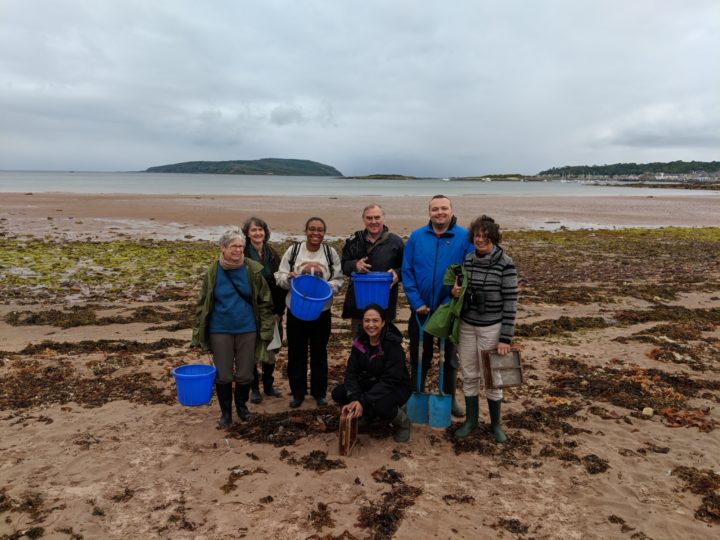Linnean Society Field trip to the Isle of Cumbrae
Published on 14th August 2018

This year, for our field trip, the Linnean Society went to Scotland’s most accessible island, the Isle of Cumbrae. We haven’t done a field trip in a few years and decided to bring them back in a revamped format in conjunction with the Field Studies Council. They weren’t wrong about it being Scotland’s most accessible island. It was a long journey from London, two trains, a ferry and bus ride, but an easy one. Once you got to Largs, which was a straight train from Glasgow, the ferry left every 15 minutes and on the other side the bus arrived the same time as the ferry and dropped you right outside the field centre.
Once we arrived we were put straight to work. The first evening session consisted of setting traps, humane ones of course. We set moth traps, mammal traps and a camera trap to hopefully capture the night time activities of otters. According to Jack, our tutor for the weekend, the mammal traps saw the same creatures coming back. It was a bit like a night’s stay in a luxury hotel for them, as there was
shelter and enough food and water for the night.

We ended Friday evening bird and dolphin watching. We saw Gannets in a feeding frenzy, it was truly amazing watching these birds dive from great heights. Gannets can dive from 30 m high, achieving speeds of up to 100 km/hour, enabling them to catch fish much deeper than other airborne birds. They are one of the few birds to dive with their eyes open. We also spotted the lone resident dolphin named either ‘Colin’ or ‘Kylie’ depending on who you ask. They don’t know much about this dolphin, but what is very interesting is that this dolphin is only ever seen alone, even though dolphins are extremely social creatures.
After a bit of dolphin spotting, it was time to call it a night. A few of us were lucky to have sea views from our bedrooms so I know some tried to see if they could spot Kylie again from their rooms.
Saturday morning saw us revisit our traps. Our camera trap wasn’t so successful. We did catch some creatures on camera but not the otters we were expecting. Instead our bait attracted a couple of shore rats. Our other traps, however, were more successful. We caught a range of moths, including two lovely and quite lively large yellow underwings and our mammal traps caught three field mice. After safely returning them we got onto our next task which was plankton sampling. I think we were all surprised by how much we enjoyed this session. It was really fun getting the microscopes out and trying to identify all the plankton we saw. The colours and shapes made it all quite mesmerising.


After lunch we got to spend the afternoon on the rocky shore. We learnt about quadrat sampling and the different types of animals and seaweeds we find along the rocky shore. From the lichens that dominate the splash zone right down to the lower shore where all the sea urchins, crabs, starfish and brittle stars live. After sampling we took a drive around the island and had a few stops to look at the immense views. The circumference of the Island is only 10 miles long and so it as become a bit of a cycling destination for tourists. Saturday ended with a talk on the natural history of Cumbrae and the other islands that make up the Clyde Islands.
Fun Fact: Curling stones are made from a certain type of granite that is only found on Ailsa Craig, an island south of Cumbrae.
Well the day didn’t really end there. After Jack finished his talk and left. We all stayed behind to look at more plankton. I did say we really enjoyed that session.
On the Sunday we had our final activity which was analysing the sandy shore. This time we learnt about transects and dug up a lot of worms, and I mean a lot of worms! We saw way too many lugworms and ragworms. Although, the ragworms were gorgeous to look at, they have these beautiful colours and they undulate, which is pretty captivating to look at. It’s easy to forget they are carnivorous and like to bite, so don’t hold onto them for too long. Up until this point we have been very lucky with the weather. It had been extremely sunny and surprisingly warm, not what we would expect from Scotland. We couldn’t leave Scotland without experiencing some proper Scottish weather and Sunday did not disappoint. As soon as we finished the morning activity the heavens opened and we had to rush back to the centre. Back at the centre we had a bit of time to head around the museum and aquarium before making our journeys back home.

Overall, it was an extremely enjoyable weekend, where we learnt a lot about the ecology and the natural history of the island. The Field Studies Council were amazing, friendly hosts and Jack was extremely knowledgeable about Cumbrae and the local ecology. If you are looking for a lovely, easily accessible island with stunning views and a relaxed atmosphere the Isle of Cumbrae should be your next destination.
Leanne Melbourne, Events and Communications Manager
